Opening Assembly: November 16 (Fri) Nagasaki City Peace Hall
| 13:00 | Opening Declaration |
High School Peace Messengers |
| Opening Address | Mr. Tomihisa Taue, Mayor of Nagasaki | |
| Welcome Greetings | Mr. Houdou Nakamura, Governor of Nagasaki Prefecture |
|
| Greetings by a Guest | Mr. Nobuharu Imanishi, Director, Arms Contorol and Disarmament Division Ministry of Foreign Affairs |
|
| Greetings by NGO Representatives | Ms. Jacqueline Cabasso, Exective Director, Western States Legal Foundation; North American Coordinator, Mayors for Peace |
|
| Prayers for Peace | Meeting of Religious Leaders |
|
| 13:40 | Keynote Report | Prof. Masao Tomonaga, Chairman of the Organizing Committee, Nagasaki Global Citizens' Assembly for the Elimination of Nuclear Weapons |
| Keynote Speech | Mr. Kurosawa Mitsuru, Professor, Osaka Jogakuin University, Founding President of the Japan Association of Disarmament Studies |
|
| Music | Piano: Ms. Ishikawa Ayumi, Flute: Ms. Nagatome Yuka |
|
| 14:30 | Message by a hibakusha | Mr. Syouhei Tsuiki |
| Songs | Chorus: Hibakusha Choir ''Himawari'' (Sunflower) |
|
| 14:50 | Closing |
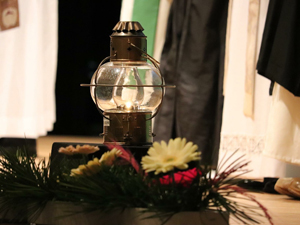 |
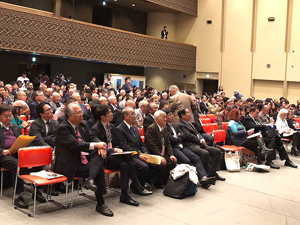 |
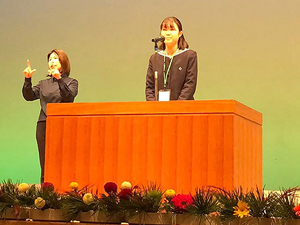 |
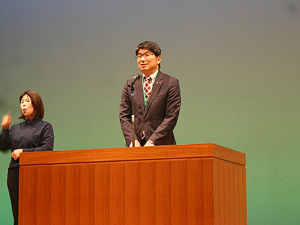 |
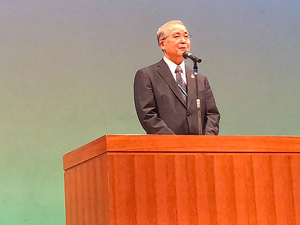 |
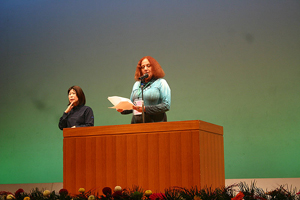 |
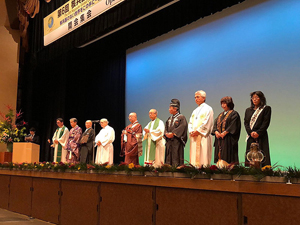 |
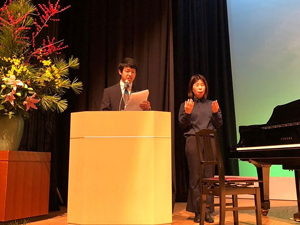 |
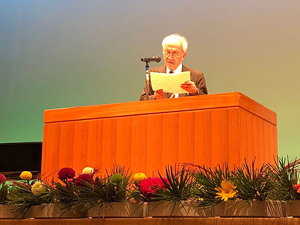 |
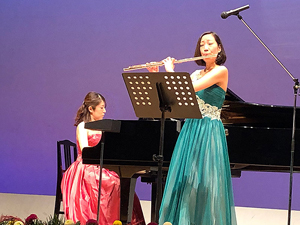
| 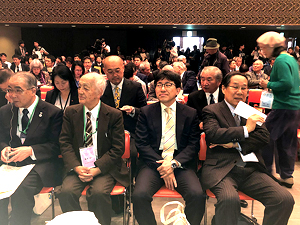 |
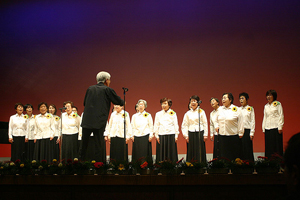 |
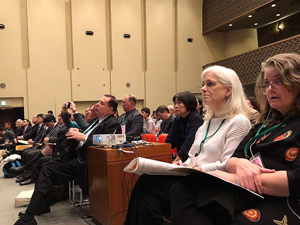
| 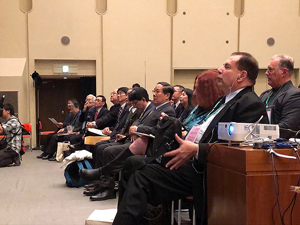 |
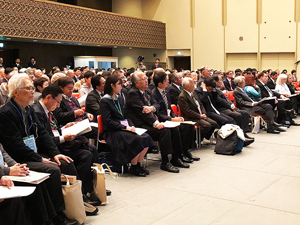 |
Opening Declaration
Suzuka Nakamura High School Peace Messengers
Hello Ladies and Gentlemen. My name is Suzuka Nakamura, and I am a third-year student at Kwassui
Senior High school. I am engaging in activities as a Nagasaki Peace Messenger. We Nagasaki Peace
Messengers and the Executive Committee of the 10,000 High School Students Signatures Campaign
undertake daily activities following the slogan of “little is not powerless.” Nagasaki Peace Messengers,
having our 21st year this year, visit the United Nations Headquarters located in Geneva, Switzerland,
every year to deliver the signatures collected, and the total number of signatures exceeds 1.78 million. In
addition, we visit various parts of the world including South Korea, the Philippines, Norway, and spread
the appeal of the abolition of nuclear weapons in the world.
As we have been nominated officially as a candidate for the Nobel Peace Prize this year, we think that the
awareness of our activities and the influence of our voices have increased further. As a youth of Japan, the
only victim of the war-time atomic bomb attacks, and as one of its citizens, we firmly inherit the baton of
peace from Hibakusha (atomic bomb survivors) and people who experienced war, and are working hard to
truly realize a peaceful world without nuclear weapons.
However, even now, after 73 years since the atomic bombing, there are 15,000 nuclear weapons and we
are caught in a dangerous situation where the movement of abolishing nuclear weapons is not progressing
globally. We are standing right at a crossroad of choosing the end of humanity or the end of nuclear
weapons.
In order to avoid repetition of the tragic event of Nagasaki and Hiroshima, we must now deliver to the
world from Nagasaki again that the abolition of nuclear weapons is the only way. Of course, we, young
people, will continue to raise our voices until the last nuclear weapon is gone, following the slogan of “little
is not powerless.”
This assembly is aiming at “achieving a world without nuclear weapons” with the encouragement of the
“Treaty on the Prohibition of Nuclear Weapons and Nobel Peace Prize Winning by ICAN” last year.
Believing that this assembly will be the first step for this noble purpose to be launched, hereby I declare the
opening of “the 6th Nagasaki Global Citizensʼ Assembly for the Elimination of Nuclear Weapons.”
Opening Address
Tomihisa Taue Mayor of Nagasaki
Hello Ladies and Gentlemen. We sincerely welcome the people who gathered from home and abroad to
“the 6th Nagasaki Global Citizensʼ Assembly for the Elimination of Nuclear Weapons.” We would like to
express our sincere gratitude to all the staff, including Dr. Tomonaga who prepared this assembly today.
This 6th Global Citizensʼ Assembly is held for the first time in 5 years. Whenever it is held, the
international situation is different. The situations this time, including the adoption of the Treaty on the
Prohibition of Nuclear Weapons at the United Nations and the reception of the Nobel Peace Prize by
the International Campaign to Abolish Nuclear Weapons (ICAN) last November, is moving in the same
direction as what we are aiming at as described in the title.
On the other hand, there are a number of extremely worrisome movements, such as the situation of nuclear
weapons development around North Korea - how this negotiation would progress, the situation of the
nuclear agreement with Iran, or how American nuclear weapons policy advances, which are progressing
at the same time. Comparing it to the flow of a river, while we are trying to reach the big ocean of a
“world without nuclear weapons” of our end, there is also a backflow to counteract it, moving upstream
simultaneously from the lower part of the river.
In the middle of this situation, firmly seeing the two movements occurring on the surface of the river in
our civil society, we need to think about what we can do to make this Treaty on the Prohibition of Nuclear
Weapons a norm and a rule shared in the world in a substantial meaning, like a downstream flow from the
upper part of a river.
On the other hand, I think that it is a big role for civil society to create a movement that flows in the bottom
of this river. It is very important to create a culture of peace and to create a world opinion of creating
a world without nuclear weapons. This Nagasaki Global Citizensʼ Assembly was born as a venue for
communicating the very voices of civil society to the world and has been contributing to this.
I would like to make this assembly a place where we communicate with the world on what people are
thinking about in civil society, as well as on our desire that we will never give up on a world without
nuclear weapons, and certainly realize it together with you.
I also would like to tell you that we are working steadily on connecting aspirations beyond generations, the
most difficult of all and most important thing, and trying to accomplish it.
As we just have been told, young people not only in both Nagasaki and Hiroshima but also around the
world are beginning to move for peace, regardless of countries. I hope that this Global Citizensʼ Assembly
is a place where we can show that civil society has a toughness never to be defeated beyond generations.
Again, this Global Citizensʼ Assembly, first born thanks to Mr. Ito, the former Mayor of Nagasaki, Dr.
Tsuchiyama, and many others, has observed its sixth time. Hoping that this assembly will be fruitful this
time as well, I would like to make the slogan of “little is not powerless” referred to in the speech by the
high school student, a watchword we share in the entire civil society, not dedicating it only for young
people.
I sincerely thank all of you who worked to prepare this assembly and I sincerely pray that this 6th assembly
will be a great opportunity to create the power to aim at a world without nuclear weapons, and I would like
to conclude my remarks with this. Thank you for your time.
Welcome Greetings
Houdou Nakamura Governor of Nagasaki Prefecture
Hello Ladies and Gentlemen. Thank you very much for the introduction. I am Houdou Nakamura, the
Governor of Nagasaki Prefecture. In the opening of “the 6th Nagasaki Global Citizensʼ Assembly for
the Elimination of Nuclear Weapons,”
I would like to extend a heartfelt gratitude to all of you who are
participating in this assembly and express my deepest welcome to everyone who had gathered from home
and abroad. Also, I would like to extend my gratitude and sincere respect to all of you who are present at
this assembly for making great efforts to abolish nuclear weapons and realize world peace.
As you know, on August 9, 1945, one atomic bomb was dropped here over Nagasaki destroyed the town
of Nagasaki and took so many precious lives instantaneously. Seventy-three years - it may seem long but
short when seen from now - have passed since then. The town which was devastated so severely has been
rejuvenated into a beautiful town which wishes for peace through the exhausting efforts of people who
survived the destruction.
However, the sorrow of the bereaved family who lost their beloved family is not yet healed, and there are
still a lot of people suffering from the aftereffects of the atomic bomb. Against this backdrop, there was a
movement to expand the role of nuclear weapons in the United States and Russia this year, and it turned
out that a sub-critical nuclear test was conducted in the United States in December last year.
Meanwhile, concerning the situation on the Korean Peninsula, the summits between North and South
Korea and the US-North Korea summit were held and agreement was reached on working toward the full
elimination of nuclear weapons on the Korean Peninsula, where we can see a growing momentum towards
the abolition of nuclear weapons.
Mr. António Guterres, Secretary-General of the United Nations, who attended the Nagasaki Peace
Ceremony on August 9 this year, made an appeal to the world with the remarks that “Let us all commit to
making Nagasaki the last place on earth to suffer nuclear devastation.” Nuclear weapons are weapons that
must not be used for any reason.
Today, we are worried that the Hibakusha are becoming older and their experience is becoming weathered.
Going forward, we will continue to pass the story of the realities of the atomic bombings down beyond
generations, and we hope that a lot more people will visit the atomic bombed places to understand the
realities, believing in realizing a world without nuclear weapons with no further delay. The Nagasaki
citizens will continue to tell the people of the world about the misery of the atomic bomb and the atrocity
of nuclear weapons with the wishes of “making Nagasaki the last atomic bombed place,” and would like to
strive to realize a world without nuclear weapons, as well as the permanent peace of the world. I would like
to ask the participants here to send a powerful message for peace from Nagasaki.
Also in Nagasaki, “the Group of Eminent Persons for Substantive Advancement of Nuclear Disarmament”,
sponsored by the Ministry of Foreign Affairs, was held until yesterday. I heard that some of the Group
members are also participating in this assembly and am strongly hoping for further discussion regarding
this.
I wish a lot of success out of this assembly and the good health and future prosperity of all the people who
have gathered here. I would like to conclude my welcoming and gratitude remarks. I am looking forward to
the next three days. Thank you very much
Greetings by a Guest
Taro Kono Minister for Foreign Affairs of Japan
Read by Nobuharu Imanishi
Director, Arms Contorol and Disarmament Division
Ministry of Foreign Affairs
Opening Address
Tomihisa Taue Mayor of Nagasaki
I would like to offer my congratulation on holding “the 6th Nagasaki Global Citizensʼ Assembly for the
Elimination of Nuclear Weapons,” and would like to express my respects to everyone on the executive
committee, as well as other concerned persons who have made efforts to hold this assembly. Seventy-three
years ago saw the atomic bomb dropped over the skies of Nagasaki. The joining together of the citizens
of Nagasaki City and Nagasaki Prefecture at this assembly aiming at realizing a peaceful world without
nuclear weapons is of immense significance.
I myself attended the Nagasaki Peace Memorial Ceremony last year and this August 9 after taking office
as Foreign Minister. Therefore, as the only country in the world to be a victim of nuclear bombing during
a time of war, listening to the voices of many people who wish to realize a world without nuclear weapons,
including the Hibakusha, I was made to think again that Japan should make further efforts to eliminate
nuclear weapons.
In recent years, the approach to seek a world without nuclear weapons has various positions. Japan, aiming
to bridge the countries in different positions, established “the Group of Eminent Persons for Substantive
Advancement of Nuclear Disarmament” last year. In the past two meetings held in Hiroshima and Tokyo,
16 experts in both nuclear-weapon states and non-nuclear-weapon states had lively discussions. As a
result of efforts of the Group members with completely different positions converge, I myself received
recommendations that contribute to the substantial progress of nuclear disarmament.
I attended the Second Session of the Preparatory Committee of the Review Conference of the Treaty
on the Non-proliferation of Nuclear Weapons (NPT) in April this year with the recommendations and
introduced them widely to the international community, inviting concrete actions. And for the two days
until yesterday, the third meeting of the Group of Eminent Persons was held here in Nagasaki, where we
had discussions about “difficult problems” on the relationship between security and disarmament. I hope
that the results of the discussions at the Group of Eminent Persons will also contribute to the progress of
the NPT operation review process. Japan will continue to actively contribute to such efforts to promote
concrete nuclear disarmament.
Nuclear disarmament cannot be promoted only by government efforts. Cooperation with the people in
civil society, including NGOs, is indispensable. Here in the city of Nagasaki, pioneering efforts by young
people, such as the Nagasaki Peace Messengers, have continued for more than 20 years to send messages
of eliminating nuclear weapons to the world. In the field of disarmament/non-proliferation education, since
1983, we have invited diplomats to Hiroshima and Nagasaki from among a cumulative total of more than
950 diplomats of each country across the world through the framework of the United Nations Program
of Fellowships on Disarmament, and told them about the atrocity of nuclear weapon based on the atomic
bomb experience. We would like to continue our efforts to spread the realities of the atomic bombing
beyond the generations and borders.
In closing, I pray for the success of this “the 6th Nagasaki Global Citizensʼ Assembly for the Eliminations
of Nuclear Weapons” and I sincerely hope that the efforts of the people concerned will produce meaningful
results.
Taro Kono, Minister for Foreign Affairs, on November 16, 2018.
Speech by a NGO Representative
Jacqueline Cabasso
Exective Director,
Western States Legal Foundation
North American Coordinator,
Mayors for Peace
Hello everyone. Thank you very much. It is an honor to be part of the opening ceremony of the 6th Global
Citizensʼ Assembly.
I have attended all of the six assemblies. I am also glad that I am able to participate
in this assembly together with your wonderful Mayor Taue, as an American coordinator of the Mayors for
Peace. When we gather here, we can truly know the hearts of Nagasaki. The people of the world respect
the leadership and inspiration of the people of Nagasaki and Hibakusha.
I truly believe in historical apologies. As an American citizen born after World War II, I feel very
embarrassed and regrettable that the US government has not apologized for the atomic bombings of
Hiroshima and Nagasaki. The door to the nuclear era, unfortunately, had been opened because of them.
An apology is also to admit that a mistake was committed. And in the case of Hiroshima and Nagasaki -
it was dropped, we have to start from acknowledging this mistake. That dreadful atomic bombing can by
no means be justified. Mr. Takashi Hiraoka, the Mayor of Hiroshima at that time, said in the International
Court of Justice in Hague in 1995, “History is always written by the winner of war. We have been told that
Hiroshimaʼs terrible genocide can also be absolutely justified. As a result, we have not been facing directly
to this influence that was given to the future of humanity for 50 years.”
But at that time, John McNeill, the American armament officer, said as follows. “We think that we have
saved millions of people from the disaster of war for fifty years with the deterrence of nuclear weapons. In
that sense, we have been using nuclear weapons every day. In other words, we avoided war and kept peace
by using nuclear deterrence.” Thus, the world is divided into two now. Nuclear armaments are really about
to expand now.
The obligation to sincerely negotiate nuclear abolition as early as possible, which is stated in the NPT
Treaty of 1970, is ignored and violated by countries that have such nuclear weapons.
Then at the Special Session of the General Assembly devoted to Disarmament in 1982, Mr. Araki, the
Mayor of Hiroshima at the time, said, “Hiroshima is not just a witness of history, Hiroshima is really a
warning that will never end for future generations. It is obvious that this mistake will be repeated again and
humanity will end if Hiroshima is forgotten.”
And Mr. Hitoshi Motoshima, Mayor of Nagasaki, also said, “Nagasaki should be the last city to have a
nuclear weapon dropped in the world forever.” Therefore, civil society can play a big role for that end.
Hiroshima and Nagasaki shall not be forgotten. That is why we are gathering here today.
As for nuclear weapons, there are many more hot spots than ever. In that situation, a new diplomatic door
was opened for the Korean Peninsula. A campaign of Candlelight Revolution (candle fire revolution)
elected President Moon Jae-in in Korea. They have called for reunification and normalization of the Korean
Peninsula so far. With it, the door to new diplomacy is opened, and the tension in the area is about to be
relaxed somewhat. Civil society around the world should also be inspired by the Candlelight Revolution.
The Treaty on the Prohibition of Nuclear Weapons also prohibits intimidation with the threat of using
nuclear weapons. That is why we should insist that the ideology of nuclear deterrence lacks legitimacy
and should be stigmatized. And it can be said that our work is exactly clear. We have to take a bottom-up
approach. We should move public opinion in order to achieve a world without nuclear weapons as well as
a fair, peaceful, and environmentally friendly sustainable society.
Not depending on the ideology of nuclear deterrence based on fear with no reason, we must promote a
campaign with more reason that reminds us of the fear of using nuclear weapons. In other words, it leads to
stopping the modernization of nuclear weapons and calling for their elimination from the earth, resulting in
a dramatic reduction in armaments. Then, we will be able to use huge resources to cope with the universal
human needs that are now desperately needed.
Keynote Report
Masao Tomonaga
Chairman of the Organizing Committee,
Nagasaki Global Citizensʼ Assembly for the Elimination of Nuclear Weapons
Thank you for attending “the 6th Nagasaki Global Citizensʼ Assembly for the Elimination of Nuclear
Weapons.” This is not in the manuscript, but I particularly want to say here is that college students from
overseas are participating for the first time. We have 2 from the United States, 5 from Malaysia, 5 from
China and 5 from South Korea.
Please stand up, foreign students.
Thank you very much for taking part in this assembly.
Five years have passed since the last and the 5th assembly in 2013. The world tide of the elimination
of nuclear weapons has dramatically developed, spreading discussions about the inhumanity of nuclear
weapons, and evoking international public opinion. As a result of multilateral negotiations, the Treaty on
the Prohibition of Nuclear Weapons (TPNW), which was formed against the inhumane threat of the nuclear
weapons, was finally adopted by the United Nations on July 7, 2017. As of the beginning of October, 69
countries have signed and 19 countries have ratified it. The early entry into force of the TPNW will be
awaited.
Furthermore, in December of last year the Nobel Peace Prize was awarded to the ICAN, which had made
a great contribution in the past, and the Nagasaki citizens who have played a part of its activity with
Hibakusha were given great pleasure and new courage.
However, the nation group of 30 countries, including nuclear-weapon states and their allies such as Japan
and NATO countries, is still continuing the war deterrence policy by nuclear weapons, refusing negotiation
of the TPNW, and even oppressing the TPNW promoting side, without signing, referring to the worldwide
security confusion.
Such two major trends show signs of the division of approaches to nuclear elimination, and in relation
to the sublime common goal of “realizing a world without nuclear weapons” that is stated in Article 6 of
the NPT Treaty, the nuclear disarmament is forced to be stagnating. The citizens of Nagasaki, an atomic
bombed place, regard this as a serious situation.
This year, in Northeast Asia where Japan is located, there is a major change in the situation regarding
nuclear weapons. That is, the dialogs by the leaders between North and South Korea and the United States
and North Korea, aiming at the peace-building of the Korean Peninsula and denuclearization of North
Korea, have been carried out successively, and have produced a major turning point. From last year, the
composition of the violent confrontation against the backdrop of the threat of nuclear weapons in this area
is suddenly changing to a direction of peace and denuclearization. We welcome this new situation and are
watching it with expectation. I believe that confidence building arising from dialogs is the only way to
overcome measures depending on nuclear deterrence.
The main theme of this “Nagasaki Global Citizensʼ Assembly” is to explore a new direction by unlocking
the civil societyʼs power, which is symbolized by the power of TPNW and Nobel Peace Prize Winning by
ICAN. Together with nuclear armament issue researchers, nuclear policy experts, NGO representatives,
citizens, Nagasaki citizens, students and children here, I sincerely hope that the debate will progress
towards a policy to be actually pursued for denuclearization in Northeast Asia including Japan through
the possible denuclearization brought about by the dialog and confidence building which are currently
proceeding on the Korean Peninsula and through Nagasaki - the last atomic bombed place for 73 years -
overcoming this division as a symbol of international norm that “nuclear weapons are never again to be
used.”
Although it is still necessary to make further efforts for the entry into force of the TPNW, I would like to
conclude this keynote report wishing that your three-day discussions at this assembly will confirm that the
TPNW becomes an international norm, as a strong complementary treaty for the NPT regime, aiming at a
new world without nuclear weapons.
Thank you for your attention.
Keynote Speech
Mitsuru Kurosawa Professor, Osaka Jogakuin University Founding President of the Japan Association of Disarmament Studies
Thank you very much for kind introduction. I am Kurosawa of Osaka Jogakuin University.
(Slides are used below)
#1
I am also an advisor to Nagasaki University and I am a frequent visitor to Nagasaki.
It is a great honor to be nominated as a keynote speaker of such an important assembly today, and I am
grateful for this opportunity and appreciate it. First of all, I would like to say thank you to the executive
committee members chaired by Dr. Masao Tomonaga, and I would also like to thank Mr. Tomihisa Taue,
Mayor of Nagasaki, and Mr. Houdou Nakamura, Governor of Nagasaki Prefecture, from the bottom of my
heart.
#2
As for todayʼs keynote speech, I will talk about three major themes. The first is the “Current Situation
Surrounding Nuclear Weapons.” As other speakers have referred to so far, there are various problems
moving, so I will touch on them. Secondly, I will broadly view the problem of “Humanity and Security”
and talk about how to think about humanity and security. Thirdly, I will talk about “Two Approaches to
Nuclear Abolition,” which contains the stigmatization now stated in the Treaty on the Proliferation of
Nuclear Weapons with a meaning of marking an evil brand on the nuclear weapons as one approach, and
making nuclear weapons non-justifiable as the other approach. I will talk about a total of nine themes with
three in each of three major themes, so please listen carefully with the ordering in mind.
#3
Regarding the first major theme, the “Current Situation Surrounding Nuclear Weapons,” I will talk about
three problems. The first is “the formation of the Treaty on the Prohibition of Nuclear Weapons,” which has
sometimes been referred to in the preceding speeches and is also taken as the sub-theme of this assembly.
What is the meaning of this? Secondly, I talk about “North Koreaʼs nuclear problem.” And thirdly, as
there was talk of withdrawal from the NPT Treaty, in addition to this, I will talk about the entire nuclear
disarmament of the 50th anniversary of the Treaty on the Non-Proliferation of Nuclear Weapons.
#4
Regarding 1-1, “the formation of the Treaty on the Prohibition of Nuclear Weapons,” as I have mentioned
it earlier, the treaty was adopted by a vote of 122 in favor, 1 against and 1 abstention at the General
Assembly of the United Nations on July 7, 2017. It was opened for signature of the treaty on September 20
of the same year, and ICAN received the Nobel Peace Prize on October 6. ICAN was awarded the Nobel
Peace Prize owing to its prominent work from the idea of the treaty to the adoption of the treaty.
There are 69 signatures by my latest information. Let me know if this is wrong. Nineteen states have
ratified it, and ratification is gradually progressing, but it is necessary that 50 states ratify it for the Treaty
to enter into force.
I understand that the formation of this treaty is an extremely large step towards the abolition of nuclear
weapons. This is the execution of Article 6 of the Treaty on the Non-Proliferation of Nuclear Weapons, and
should be highly evaluated. Therefore, 1-1 shows the problem that NGOs should make further efforts from
various aspects towards the early enforcement of this treaty.
#5
Next, 1-2 is “North Koreaʼs nuclear problem,” and there is also a workshop for this. The summits between
North and South Korea were held three times this year, and the “Panmunjom Declaration” was agreed on
April 27, and the “Pyongyang Joint Declaration” was agreed between the leaders of North Korea and South
Korea on September 19.
Meanwhile, the first summit was held between the United States and North Korea on June 12 in Singapore,
and a joint statement between President Trump and Chairman Kim Jong Un was issued. In this statement,
the major agreement was to provide security guarantees with North Korea. For this, the determination to
denuclearize the Korean Peninsula was expressed and it is understood that they are currently proceeding
towards complete denuclearization, and the second summit is planned at the beginning of next year.
As a future task, there are two issues: the provision of guarantee of safety to North Korea, and how to
implement the complete denuclearization of the Korean Peninsula. Regarding the future negotiations, it
is expected that while promoting trust between the United States and North Korea, final solutions will be
brought about. However, in reality, there are various difficulties and challenges. In that sense, forwardlooking efforts are required for the countries concerned, and especially in this regard, I think that NGOs
should also make efforts for a peaceful solution internationally or in each country. This is the second
problem surrounding the current nuclear issue.
#6
Regarding the third problem, 2020 will see the 50th year from when the treaty came into force, that is, the
“50th anniversary of the Nuclear Non-Proliferation Treaty.” A review meeting will be held. The current
status of nuclear disarmament is very hard. In fact, nuclear-weapon states are continuing with nuclear
armament races, nuclear weapons have been modernized, violations of the INF Treaty are discussed
between the United States and Russia, and the United States has expressed its intention to withdraw from
the treaty.
Another long-term task is whether the new START treaty is extended or not; otherwise, it will expire.
Since the summit of the United States and Russia will be held at the next G20 on whether to start a new
reduction negotiation or not, I think that will be discussed there.
So the second problem is that the treaty-supporting states and the treaty-opposing states are confronted
sharply and divided over the Treaty on the Prohibition of Nuclear Weapons. Although the Japanese
government is holding the Group of Eminent Persons etc., as explained in the previous speech, it is
indispensable to build a bridge between them, and how to progress this is an important issue. In this regard,
I think that NGOs should help support the development by using their wisdom.
Finally, with respect to the prospect of the NPT Review Conference in 2020, if the current situation
continues, I think that the conference will end in failure and we will not be able to hope for new progress
towards nuclear disarmament. Therefore, concrete results are required here, especially for matters such
as the negotiations or reconciliation between the United States and Russia over the withdrawal of the
INF Treaty, and how far nuclear-weapon states take measures such as the reduction of the role of nuclear
weapons.
#7
I will proceed to the major second problem. In “Humanity and Security”, I have attached “human beings”
after the “Humanity.” While talking about such things, I also talk about what each approach is, and how the
humanitarian approach is different from the security approach. Secondly, the concept of security has been
expanding very much recently. We need to consider how it will be formed.
So I combine security and humanity to talk about whether we can think of “Security of Humanity (human
beings),” and I will make a suggestion that such the “Security of Humanity (human beings)” should be
incorporated into the basic idea.
#8
First, regarding 2-1, there has traditionally been the “humanitarian approach and security approach.” From
the viewpoint of the humanitarian approach, the use of nuclear weapons has a devastating effect. Centering
on that, it pursues the abolition of nuclear weapons. The Treaty on the Prohibition of Nuclear Weapons just
rides on that idea.
At the NPT Review Conference in 2015, a joint statement was issued by 159 states, supporting this
humanitarian approach. Then, the idea that both security and humanitarian aspects should be considered
was argued as a joint statement by the 26 states under the nuclear umbrella at the Review Conference in
2015. The Japanese government is in favor of both of them. Under such circumstances, another position is
the one of nuclear-weapon states, where the security is a prerequisite for nuclear disarmament, a complete
security approach. The problem of 1 is that the traditional humanitarian approach and the security approach
are claimed by each country in this way.
#9
The problem of 2 is that the concept of security has recently expanded in international politics and how
it should be understood in that case. Traditionally, security in a very narrow sense has meant the military
security of the state. Therefore, it is the idea of defending the safety of the country by armaments. However,
in recent developments, the idea is spreading vertically from the level of a nation state to international
security and up to the form of global security.
And it is spreading downward in the form of human security. It is a vertical relationship. Horizontally,
the concept of security had been of military security in the past; however, now it has expanded and used
widely in the form of environmental security, energy security, food security, water security, and economic
security.
This means that the military of the country is important, but various such new problems are as important as
the military of the country. It was said in the past that military affairs were high politics. So, there was also
low politics, which is now also told in the concept of security
#10
Based on that trend, thirdly, here, I would like to set a new objective for alternative nuclear disarmament
by “human security,” in the form of combining security with humanity. The humanitarian approach and
security approach can be overcome, and both are united to form a new objective of “human security.” This
is very funny when you are listening in Japanese, because “humanity” and “human beings” are different
words in Japanese.
However, the word humanity in English has the meaning of both “humanity” and “human beings.” So
“Security of Humanity” means “humanitarian security.” This concept is very cooperative in its content,
including all persons and human beings as a whole, and human security is also important, it is targeting
individual human beings. However, should we think about human beings as a unit that may be ruined if
nuclear weapons are used? This conference is an assembly called a global citizensʼ, which means human
being itself, so I think that a similar idea is included in the title of this conference.
#11
Thirdly, regarding the approaches to the abolition of nuclear weapons, as I have mentioned earlier that
there are two, one is to stigmatize nuclear weapons or “to mark an evil brand on them.” The other is to
delegitimize nuclear weapons or “to make them unjustifiable.” I will talk about what these two approaches
are and what the relationship is, in order.
#12
First, I talk about “marking an evil brand on nuclear weapons.” This is a humanitarian approach. I think that
you know the humanitarian restrictions Austria has done, where they stated that nuclear weapons should be
stigmatized, prohibited, and abolished.
The Treaty on the Prohibition of Nuclear Weapons is conforming exactly to this approach, and activities
related to nuclear weapons are broadly prohibited in Article 1 of the Treaty. Therefore, although this does
not directly regulate the abolition of nuclear weapons, it plays a major role in the formation of a legal norm
that nuclear weapons should be prohibited.
#13
Next, regarding delegitimizing nuclear weapons or “making them unjustifiable,” this is also based on
the humanitarian approach to nuclear abolition, which is the proposal in the report of the “International
Commission on Nuclear Non-proliferation and Disarmament (ICNND)” issued in 2009 and sponsored by
Japan and Australia.
Another proposal was made in the 2010 report by the James Martin Center for Nonproliferation Studies. In
the report, they advocated measures such as the reduction of nuclear weapons, no first use, and lowering or
releasing the alert situation, by promoting lowering the role of nuclear weapons. In addition, arguments for
criticism against the nuclear deterrence theory, reducing and depriving the legitimacy, value and fame of
nuclear weapons compose a story of making them unjustifiable.
#14
In 3-3, I talk about how these two approaches relate to each other and whether or not they conflict with
each other. When comparing and examining them, the objective of abolishing nuclear weapons is the same.
However, they are different in the reason for eliminating nuclear weapons, its means and effectiveness, the
way of thinking about security and nuclear deterrence.
Therefore, although both approaches specifically take different methods and means, considering from
the point of view that the objectives are the same, you should consider them to be complementary, not to
be confrontational or mutually exclusive. So, these two approaches should be pursued at the same time.
Although each has its own approaches, I think that various approaches should be pursued in parallel for
eliminating nuclear weapons, without excluding others.
#15
I will now conclude this talk. Based on the three major themes, while there is a very successful result of the
formation of the Treaty on the Prohibition of Nuclear Weapons, the current situation surrounding nuclear
weapons does not allow us to be optimistic in terms of the progress of nuclear disarmament because the
ongoing nuclear problem of North Korea is critical. In that sense, I think that more discussion is needed
and NGOs are required to make further efforts.
Regarding the promotion of the nuclear disarmament of the second, I think that we should think about the
security of global citizens on the basis of a humanitarian approach, based on a new concept of “human
security.”
As for the approach to nuclear weapons, we should adopt both approaches to stigmatize nuclear weapons
and to make nuclear weapons unjustifiable, producing their synergistic effects.
Thank you very much for your attention.
Message by a hibakusha
Syouhei Tsuiki
I am Shohei Tsuiki, a Hibakusha. I was eighteen years old when Nagasaki was atomic bombed. And I am
ninety-one years old now. I am aging, but I still feel as vigorous as ever.
There are various pieces of news every day. Every time I hear these, some ideas come to my mind as a
Hibakusha. Today, I would like to make an appeal as a Hibakusha, talking about what I thought of.
When an atomic bomb was dropped on the City of Nagasaki at 11:02 am on August 9, 1945, I was sleeping
and exposed to the bomb in the dormitory of the Nagasaki Normal School, which was located 1.8 km
from the hypocenter. I was an eighteen-year-old student at the Normal School at the time, but there were
no classes at school and I was engaged in work to build weapons at a Mitsubishi weapons factory as a
mobilized student.
Since I was assigned to the night shift that week, I slept in the school dormitory in the daytime. Sudden
exposure caused systemic bleeding and the whole of my body turned red with soaking blood. When I went
out of the dormitory with my friend and entered into a bomb shelter, there were some 30 neighbors. All of
them were heavily burn-injured, which were too terrible to describe them in words. The eyes, the nose, the
mouth, or the ears could not be identifiable in the face, the skin of the body hung down, the entire body was
completely black, brown, or red (I was the same). They almost looked like ghosts.
There was a strange smell around, but no sound, which made me think of the end of the world. Perhaps
more than half of those people died in less than a week. The people that remained died of diseases that
seemed to be the result of radiation during the 73 years after the war, and as far as I know, now I am the
only survivor of the people in the shelter.
After that, I was rescued by my family and received medical treatment for three months at an evacuation
home for an illness possibly from the effect of radiation as well as burn injuries, and was able to get better
somehow.
I was still confined to bed when my younger brother brought an American leaflet he picked up and I knew
that the dropped bomb that had burned my body was an atomic bomb. Around a year after the atomic
bombing, I heard many things: the entire Nagasaki perished from a single drop, the prefectural government
which was 3 km away from the hypocenter and as far as the area near the city hall burned down, as far as
the area near the Nagasaki Station 1.8 km away from the hypocenter was in a state of annihilation, people
within 1 km from Matsuyama town the hypocenter were killed and charred black instantaneously, and
people as far as 1.5 km away were instantly killed by burns and blasts.
Knowing that the situation was too devastating and much worse than what I had experienced and seen at
the school dormitory and the neighborhood, even though it was a war, I became to have ideas refusing war
and atomic bombs strongly. After the war, I was sensitive to the information on nuclear weapons and war,
but nuclear-weapon states emerged one after another, nuclear tests were frequently carried out, and at the
same time the performance of nuclear weapons rapidly developed.
In such circumstances, I announced my feelings against nuclear weapons, and was doing sitting-in protests.
However, the development of nuclear weapons never stopped, and nuclear weapons were proliferating. At
the same time, however, I feel strength in the situation where many people in the world are worried about
nuclear weapons that ignore human nature and movements against nuclear weapons are spreading. I am
consistently claiming that we should abolish nuclear weapons immediately and complete prohibition. I
think of various things in the tide of the world.
There was a movement against nuclear tests in the beginning of 1960. It had a certain success, leading to
the atmospheric nuclear tests ban. Then, nuclear tests were shifted to underground tests, but eventually the
underground nuclear tests became prohibited as well. The biggest event was the NPT Treaty in 1968. First
I also highly evaluated this, although it was unequal. If it had not been for this treaty, nuclear proliferation
would have spread without being stopped and been impossible to cope with it, and I think that the chance
of nuclear war would have been very high.
In 1995, when the deadline of the treaty came, again, there was discussion of abolition or extension. I was
expecting the extension. I meant it by removing inequality in it. However, the inequality continued until
then. Nevertheless, I expected nuclear-weapon states to progress towards the reduction and abolition of
nuclear weapons under Article 6 of the NPT. However, from the NPT Review Conference held every five
years, I knew that it would lead us nowhere to rely on the conscience of nuclear-weapon states.
The United States carried out the sub-critical nuclear test last December and announced its departure from
the INF this year. I have a feeling that the abolition of nuclear weapons has greatly retreated, and I am
worried about the future. I am watching the progress to see what could happen, but I feel that the state of
the cold war has come back. Nevertheless, nuclear-weapon states are possessed by the nuclear deterrence
theory, and they do not try to be faithful to the spirit of the NPT. I find it contradictory that such a country
demands the abolition of nuclear weapons, for example, of North Korea.
As for the nuclear deterrence theory, I do not deny its effectiveness. I think that the United States and
Russia did not directly fight a war and the third world war did not happen for 73 years because they knew
the results of atomic bombing in Hiroshima and Nagasaki and did not use it. However, the existence
of nuclear weapons means that a nuclear war will eventually occur. I suggest the nuclear weapons be
controlled by the United Nations, any country not possessing nuclear weapons, and nuclear weapons be
abolished in the end, then the entire earth would become a nuclear free zone, and I suppose that real peace
would come for the first time.
In that sense, the Treaty on the Prohibition of Nuclear Weapons, adopted with the approval of 122 states
in July of last year, encourages us Hibakusha very much, with the groundbreaking content of totally
prohibiting the development, possession and use of nuclear weapons. However, I am a little worried that
ratification has not yet progressed sufficiently. I heard that this Treaty was promoted by many non-nuclearweapon states and non-governmental organizations (NGOs) from the strong sense of crisis that nuclear
disarmament cannot be developed by leaving it only to nuclear weapons states.
We Hibakusha were really disappointed and saddened by the fact that nuclear-weapon states and their
allies were in direct opposition to the Treaty, conflicted with the non-nuclear-weapon states, and the
Japanese government, which depends on the nuclear umbrella, together with the nuclear-weapon states, did
not participate in the conference either. Does the Japanese government actually understand our feelings?
I highly evaluated the summit between the United States and North Korea held in June this year and
accepted it as good news. I feel relieved to see that the state of tension surrounding North Korea is
reducing. I sometimes read the so-called Russell-Einstein Manifesto issued on July 9, 1955 in London
by the eleven most eminent scholars, such as Einstein, Russell, Dr. Yukawa, to recall it. I would like to
conclude this speech by introducing a part of it.
“... but the best authorities are unanimous in saying that a war with H-bombs might quite possibly put an
end to the human race. ―omitted―... In view of the fact that in any future world war nuclear weapons will
certainly be employed, and that such weapons threaten the continued existence of mankind, we urge the
Governments of the world to realize, and to acknowledge publicly, that their purpose cannot be furthered
by a world war, ”
Thatʼs all. Thank you very much.
